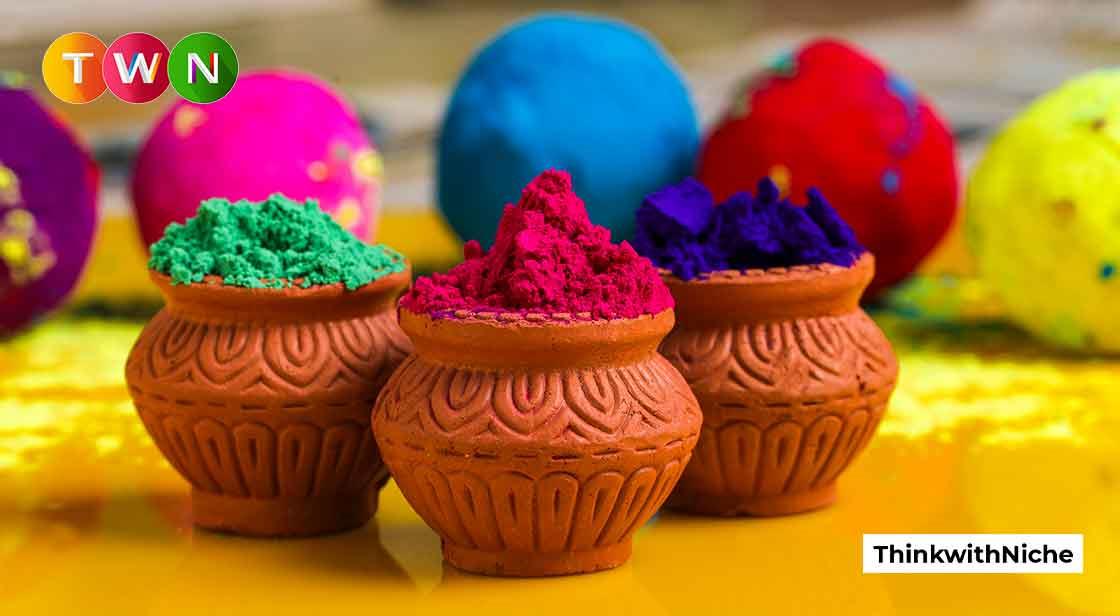Celebrating Holi, The Eco-Friendly Way!

Blog Post
India's most vibrant holiday is Holi. Holi will be celebrated on March 8 this year. It is a celebration with a bewildering variety of dazzling colours and a variety of activities that give the fiesta day life. Holi is a colorful festival that honours God's victory over the devil and serves as a reminder of the power of goodness for everyone.
Celebrations play a significant role in our lives. Nonetheless, we must keep in mind the significance of our surroundings when we are taking part in celebrations. It is our responsibility to take care of it. So let's celebrate Holi this year in a way that is environmentally friendly. The same way we now celebrate Holi will be continued, but with more consideration for the environment.
It's that time of year again when the spirit of Holi, the bright festival of colors, will pervade every nook and cranny of the country. But this year, forego the typical Holi celebrations, which include water balloons, pichkaris, and hazardous colors that have a significant environmental impact. Instead, spend the holidays in an environmentally friendly manner. Holi is India's most colorful celebration. It is a festival with a stunning array of brilliant colors and a plethora of celebrations that bring life to the fiesta day.
Holi is a colorful festival that commemorates God's victory over the devil and reminds us all of the power of goodness. Holi is a beautiful festival that celebrates the entrance of spring, and the colors utilized in the festival mirror the varied colors of this season. But, instead of all of these lovely things, Holi has become like all other celebrations, heartlessly marketed, and has become yet another source of environmental damage.
Celebrating Holi, The Eco-Friendly Way!
However, it is encouraging to see that people are becoming more aware of the negative impacts of Holi pollution and are attempting to return to more natural ways of celebrating this colorful celebration. Celebrations are an important part of our life. However, when we are involved in festivities, we must remember the importance of the environment around us. We must look after it. So, this year, let us enjoy Holi in an environmentally sustainable manner. Holi will be celebrated in the same way we do now but in a more environmentally responsible manner. Here are a few environmentally friendly methods to enjoy Holi to the fullest while also caring for the environment.
Colors That Are Eco-Friendly And Help Reduce Waste
This time, don't buy Holi colors from the store since, first, they're created with dangerous chemicals, and second, they're packaged in plastic, which ends up in our overflowing landfills or oceans. The alarming fact is that plastic is non-biodegradable, and as a result, it can last for more than 500 years on the earth. What you should do is: Rather than buying hazardous colors, go green and make your Holi colors with dried flowers or leaves, turmeric, sandalwood, and henna. To make the red color, collect any red flowers, such as hibiscus flowers. Simply powder the flowers with some flour after grinding them. Your red color is now complete. Soak Tesu flowers overnight in water or boil them for orange or saffron color. Once you have a lovely yellow-orange color, mix it with flour. Mix equal parts henna powder and flour for a green color and ground beets with flour for a pink or magenta color. A quick tip: Use wheat or gram flour to make the color in quantity. The greatest way to celebrate this colorful event is to play Eco-Friendly Holi with natural colors. Make your natural colors with turmeric, sandalwood, and henna, and use your imagination to create diverse combinations. These colors are safe to use and can be readily removed. Synthetic colors contain a variety of hazardous substances. These would not harm your skin or hair in any way.
Upcycled Products Can Be Used To Decorate Your Home
Every Holi celebration entails the task of adorning your home or neighborhood. Say goodbye to the usual party décor, which is primarily composed of plastics. Instead, try upcycling, which is simply a creative technique for reducing trash. According to the definition, upcycling is the process of repurposing discarded goods or materials to create new products. Newspapers, magazines, old books, and cardboard can be used to make colorful wall or garden hangings.
The first step is to decide on a design for the wall decorations, then paste or draw it on cardboard. After that, cut the cardboard into the shape of the chosen pattern, then cut a bunch of newspapers together. Start sticking the newspapers to the cardboard by rolling them up like a pen. Paint the cardboard once it has been completely covered in waste paper.
The last step is to use the piece of thread to hang the DIY décor item together. Make use of old CDs by transforming them into colorful coasters. Get a stack of old CDs and start painting. You can also cover the CDs with an old piece of cloth. And that's it; the bright coasters will come in handy throughout your Holi celebration.
Celebrating Phoolon Ki Holi
Holi is a festival that celebrates the arrival of spring, and in some locations, people wear floral jewelry and traditional clothing to welcome the season. If you can organize a Holi celebration in your society or at home, instead of using toxic and chemical-laden colors, it is a nice idea to use flowers. When flowers are discarded, they are simply disposed of and repurposed. Chemical-laden colors are damaging to the skin and the environment, and they contribute to pollution. It's important to remember that if you're going to play with flowers, you'll need to make plans for correct flower disposal. People in several places in North India, such as Lucknow and Pushkar, participate in this type of festivity.
Celebrating Holi Without The Use of Water
We can have a dry Holi instead of throwing water-based colors and water-filled balloons at each other. Holi should only be played with dry colors (Gulaal) and no water. In current days of water scarcity, if one person uses one bucket of water, he is using 15 liters of water, possibly more, as we also need water for color washing. A lot of water is consumed in this manner. It's a good idea to educate children by telling them that natural resources are limited and that we must use them wisely. Even if we truly want to enjoy Holi with water, it is recommended that we do so as a group using a community pool and gulaal.
Let's Understand Holi a Little More Today
As soon as the month of Falgun arrives, the waves of the Holi festival begin to rise in mind. The arrival of Holi means the arrival of the summer season. People who settled far from home get a chance to revisit their houses. The smell of snacks like; Gujiya, mathri, and khurma is spread everywhere in the environment.
Although we celebrate the new year on January 1, the Indian Hindu New Year begins only with the arrival of Holi in the month of Falgun.
Different Names of Holi
Holi has other names as well, such as Fagua, Dhuledi, Dol. During Shah Jahan's time, Holi was called 'Eid-e-Gulabi' or 'Aab-e-Pashi' (shower of colors).
Holi and Akbar
Since Emperor Akbar had very good Hindu relations in the court and he himself had a Hindu Rajput queen, therefore, in his empire, Hindu festivals were also celebrated with great enthusiasm; one of those festivals was- " Holi. ''
The Mention of Holi is also Found in Ancient Texts
Alberuni has also described Holi in his historical travel memoirs.
Holi has a Deep Connection with Classical Music Too
In classical music, songs have been composed for every season, month, occasion, person, so are the songs of Falgun month, i.e., Holi is not untouched from classical music? Holi songs sung at the dargah of Khwaja Moinuddin Chishti in Ajmer city of Rajasthan have a different vibe. Different colors of Holi are seen in every city, town, place of India.
Holi and Lord Krishna
Krishna is the reason for the celebration of Holi in Vrindavan, Mathura, Barsana, Gokul, wherever Radhakrishna's love is more scattered. Vrindavan Holi is a bit different - Holi of flowers, Holi of mud, Holi of water, Lathmar Holi. The name is one "Holi," but it is celebrated with great fervor here. At this time, images of Radha-Rani, Gopikas in girls, and Krishna and cowherd boys are seen in the areas here.
Rangbhari Ekadashi of Kashi
Holi of Lord Shiva and his ganas (Shiva followers) is celebrated and played as Ekadashi Holi. People disguise themselves as the Ganas of Shiva by applying colors, dancing, and singing in Holi.
Holi Dominates the Films
Even in films, ordinary life is lived, and festivals of ordinary life are celebrated. Rang Barse Bhege Chunar Wali, who does not remembers this song, Holi Khele Raghubira, this song tells that Rama of Ayodhya's kingdom also used to play Holi.
Festival of Bhang, Dish, and Swings
The joy of swinging happily in Holi, its shade is different, the enthusiasm of the cold, the sweetness of the dishes, and the rain of colors swell the body as well as the mind with joy.
Let's answer the question, why is Holi celebrated? i.e., the legend of Holika, due to which Holika Dahan is celebrated a day before Holi.
The Story of Holika and Prahlad i.e. Holika Dahan
Demon king named Hiranyakashyap began to believe himself to be a god and used to torture anyone who opposed him, but when his son Prahlad had peace of mind, non-violence, and only Lord Narayana as his devotion. How would Hiranyakashyap bear that he is opposing all the deities, and his son is worshiping Narayan? Hiranyakashyap explained, intimidated, but Prahlad did not agree. Finally, he asked his sister Holika to take him and sit in the fire because Holika had a boon that fire could not burn her, but on the contrary, she got burnt, and Prahlad survived, by the grace of Narayan. Since then, this day became famous as the victory of good over evil, victory of truth over falsehood, and Holika-Dahan. Human beings were taught that no matter how big the evil is, it cannot harm the good, and since then; on this day, fire is lit for Holika, and it is believed that you can burn all the bad memories and evils inside you in this Holika and you can start your life with new positive energy from the day of Holi.
Conclusion
Holi is a festival that is all about colors we spread. Playing an eco-friendly Holi is the modern call for our environment and ourselves. Gone are the days when permanent watercolors were trending. It is time to reinvest in the betterment of our nature with natural colors.
You May Like
EDITOR’S CHOICE












